Hyundai Elantra Hybrid 2023 Declaration of Conformity
In addition to providing crucial direction on how to manage emergency situations, the 2023 Hyundai Elantra Hybrid Declaration of Conformity and Emergency Situations Guidelines serve as a thorough resource to guarantee that the car conforms with all applicable safety and environmental regulations. This paper describes how the car complies with industry standards and emphasizes Hyundai’s dedication to providing a safe and ecologically friendly driving experience. It also emphasizes the brand’s commitment to the vehicle’s performance and the safety of its occupants in a variety of unforeseen events by giving drivers important information and directions for handling emergency situations.
2023 Hyundai Elantra Specs, Price, Features, Milage (Brochure)
Declaration of Conformity
The radio frequency components comply:
Front Radar
FCC ID:2ACDX-MRR-30 This device complies with Part 15 of the FCC Rules Operation is subject to the following two conditions: this device may not cause harmful interference, and 2) this device must accept any interference received, including interference that may cause undesired operation. CAUTION TO USERS Changes or modifications not expressly approved by the party responsible for compliances could void the user’s authority to operate the equipment OANATEL231
Rear Corner Radar
The antenna(a) must be installed such that a minimum separation distance of at least 20 cm is maintained between the radiator (antenna) and all persons at all times, This device must not be co-located or operating in conjunction with any other antenna or transmitter, OANATEL124
Hazard Warning Flasher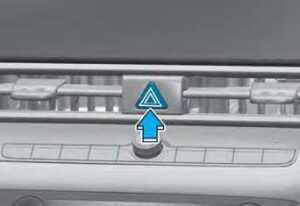
The hazard warning flasher serves as a warning to other drivers to exercise extreme caution when approaching, overtaking, or passing your vehicle. It should be used whenever emergency repairs are being made or when the vehicle is stopped near the edge of a roadway. To turn the hazard warning flasher on or off, press the hazard warning flasher button. The button is located in the center fascia panel. Both the left and right turn signal lights will flash simultaneously.
- The hazard warning flasher operates whether your vehicle is running or not.
- The turn signals do not work when the hazard flasher is on.
IN CASE OF AN EMERGENCY WHILE DRIVING
If the Engine Stalls While Driving
- Reduce your speed gradually, keeping a straight line. Move cautiously off the road to a safe place.
- Turn on your hazard warning flasher.
- Try to start the engine again. If your vehicle will not start, contact an authorized HYUNDAI dealer or seek other qualified assistance.
If the Engine Stalls at a Crossroad or Crossing
If the engine stalls at a crossroads or crossing, if safe to do so, move the shift lever to the N (Neutral) position and then push the vehicle to a safe location.
If you Have a Flat Tire While Driving
If a tire goes flat while you are driving:
- Take your foot off the accelerator pedal and let the vehicle slow down while driving straight ahead. Do not apply the brakes immediately or attempt to pull off the road as this may cause loss of vehicle control resulting in an accident. When the vehicle has slowed to such a speed that it is safe to do so, brake carefully and pull off the road. Drive off the road as far as possible and park on a firm, level ground. If you are on a divided highway, do not park in the median area between the two traffic lanes.
- When the vehicle is stopped, press the hazard warning flasher button, move the shift lever into P (Park), apply the parking brake, and place the ignition switch in the LOCK/OFF position.
- Have all passengers get out of the vehicle. Be sure they all get out on the side of the vehicle that is away from traffic.
- When changing a flat tire, follow the instructions provided later in this chapter.
IF THE ENGINE WILL NOT START
- Be sure to shift the gear to P (Park). The vehicle starts only when the gear is in P (Park).
- This vehicle does not have a regular 12V battery that needs periodic replacement. It is a lithium-ion polymer type integrated into the HEV high-voltage battery. The vehicle has a 12V battery protection system that cuts 12V batteries from the vehicle draws to prevent full discharge. If the vehicle will not start, first try pressing the 12V Battery Reset switch (left side of the steering wheel near the fuel door open switch) to reconnect the 12V battery, but you must start the vehicle within 15 seconds of pressing the 12V Battery Reset switch. After starting the vehicle ( indicator ON ), operate the vehicle safely outdoors in ready mode and stop and/or drive it for 30 minutes total to charge the 12V battery fully.
- Check the fuel level and add fuel if necessary.
If the vehicle still does not start, call an authorized HYUNDAI dealer for assistance.
NOTICE
Push or pull starting the vehicle may cause the catalytic converter to overload which can lead to damage to the emission control system.
IF THE 12-VOLT BATTERY IS DISCHARGED
Before Jump Starting
This vehicle does not have a regular 12V battery that needs periodic replacement. It is a lithium-ion polymer type integrated into the HEV high-voltage battery. The vehicle has a 12V battery protection system that cuts 12V batteries from the vehicle draw to prevent full discharge.
Using the 12V battery reset switch
- Press the 12V Battery Reset to switch to reconnect the 12V battery.
- Start the vehicle within 15 seconds of pressing the 12V Battery Reset switch.
- After starting the vehicle (indicator on), operate the vehicle safely outdoors in ready mode and stop and/or drive it for 30 minutes total to charge the 12V battery fully.
If you do not start the vehicle immediately after pressing the 12V Battery Reset switch, the power of the 12V battery is automatically disconnected after a few seconds to save the 12V battery from additional discharge. If the 12V battery is disconnected prior to starting the vehicle, press the 12V Battery Reset switch again and then immediately start the vehicle as explained. Repeated use of the 12V Battery Reset switch without a sufficient engine ON cycle (30 Min+) may cause an over-discharge of the 12V battery, which will prevent the vehicle from starting. If the 12V battery is over-discharged to the point that the reset does not work, try to jump-start the vehicle.
Information
After starting the vehicle ( indicator on), the 12V battery is charged whether the engine is running or not. Although there is no engine sound, it is unnecessary to depress the accelerator pedal. The following items may need to be reset after the battery has been discharged or the battery has been disconnected.
See chapters 4 and 5 for:
- Power Windows
- Trip Computer
- Climate Control System
- Clock
- Audio System
- Sunroof
NOTICE
External power source using 12V battery The use of external power accessories may reduce the performance and function of the vehicle. Especially, the use of dash cameras may shut off the power of the vehicle prior to the dash camera’s automatic shut-down. If the power of the vehicle is shut off, start the vehicle as explained. (refer to “Using the 12V Battery Reset Switch”)
Jump Starting
In the event the vehicle still does not have a functional 12V battery (check if interior lights will not turn on) then you can try a jump start to the engine compartment jumper terminals using a 12V booster pack or jumper cables from another vehicle’s 12V battery according to the following instructions.
CAUTION
Jump starting can be dangerous if done incorrectly. Follow the jump-starting procedure in this section to avoid serious injury or damage to your vehicle. If in doubt about how to properly jump-start your vehicle, we strongly recommend that you have a service technician or towing service do it for you.
- Position the vehicles close enough that the jumper cables will reach, but do not allow the vehicles to touch. Avoid fans or any moving parts in the engine compartment at all times, even when the vehicles are turned off.
- Turn off all electrical devices such as radios, lights, air conditioning, etc. Put the vehicles in P (Park) and set the parking brake. Turn both vehicles OFF.

- Connect the jumper cables in the exact sequence shown in the illustration. First, connect one jumper cable to the red, charging terminal inside the engine compartment fuse panel (1).
- Connect the other end of the jumper cable to the red, positive (+) battery/jumper terminal of the assisting vehicle (2).
- Connect the second jumper cable to the black, negative (-) battery/chassis ground of the assisting vehicle (3).
- Connect the other end of the second jumper cable to the black, negative (-) chassis ground of your vehicle (4).
- Do not allow the jumper cables to contact anything except the correct battery or jumper terminals or the correct ground. Do not lean over the battery when making connections.

- Press the 12V Battery Reset switch.
- Start the engine of the assisting vehicle and let it run for a few minutes.
- Start your vehicle as soon as possible. After starting the vehicle ( indicator on), operate the vehicle safely outdoors in ready mode and stop and/or drive it for 30 minutes total to charge the 12V battery fully.
If your vehicle will not start after a few attempts, it probably requires service. In this event please seek qualified assistance. If the cause of your battery discharging is not apparent, have your vehicle checked by an authorized HYUNDAI dealer.
Disconnect the jumper cables in the exact reverse order you connected them:
- Disconnect the jumper cable from the black, negative (-) chassis ground of your vehicle (4).
- Disconnect the other end of the jumper cable from the black, negative (-) battery/chassis ground of the assisting vehicle (3).
- Disconnect the second jumper cable from the red, positive (+) battery/jumper terminal of the assisting vehicle (2).
- Disconnect the other end of the jumper cable from the red, charging terminal inside the engine compartment fuse panel (1). 8- 6
Information
The voltage range of the charger should be 13.3~14V and its current range should be less than 60A. (13.8V is recommended).
CAUTION
The use of an improper charger with a voltage and current range higher than specified may cause overheating and damage to the 12V battery. The use of an incorrect charger will lead to a power shut-off to save the 12V battery. Stop using the incorrect charger once the power of the vehicle is shut off.
Information
An inappropriately disposed of the battery can be harmful to the environment and human health. Dispose of the battery according to your local law(s) or regulations.
NOTICE
To prevent damage to your vehicle:
- Only use a 12-volt power supply (battery or jumper system) to jump-start your vehicle.
- Do not attempt to jump-start your vehicle by push-starting.
CAUTION
Do not jump-start another vehicle with your hybrid vehicle. Jump-starting another vehicle will damage the hybrid vehicle’s 12-volt battery (lithium polymer type).
IF THE ENGINE OVERHEATS
If your temperature gauge indicates overheating, you experience a loss of power, or hear loud pinging or knocking, the engine may be overheating. If this happens, you should:
- Pull off the road and stop as soon as it is safe to do so.
- Shift the gear to P (Park) and set the parking brake
- Turn off the air conditioner.
- When the coolant or hot steam gushes out of the reservoir, stop the engine and we recommend that you call an authorized HYUNDAI dealer for assistance. If the coolant does not flow out, leave the engine compartment open, while running the engine. Check the coolant temperature gauge on the instrument cluster and turn off the engine to make sure the coolant temperature is sufficiently cooled down.
- Cool down the engine sufficiently and check the coolant level. When it is insufficient, check its connection with the radiator, the heater hose, and the water pump for any leakage. When there is no leakage, add the coolant. However, if the problems persist, such as the coolant leakages, the cooling-fan malfunction, or the water pump drive belt damages, immediately stop the engine, and have your vehicle checked by an authorized HYUNDAI dealer.
- You should mix antifreeze and water in a proper ratio to make coolant. If the antifreeze ratio is too high or low, it may cause overheating due to the lack of cooling function. (Refer to the Mix Ratio in “Checking the coolant level” in chapter 9.)
- If overheating happens repeatedly, we recommend that you have your vehicle checked by an authorized HYUNDAI dealer.
WARNING
While the engine is running, keep hands, clothing, and tools away from the moving parts such as the cooling fan and drive belt to prevent serious injury.
WARNING
Never remove the engine coolant cap and/or inverter coolant cap or the drain plug while the engine and radiator are hot. Hot coolant and steam may blow out under pressure, causing serious injury. Turn the hybrid system off and wait until the engine cools down. Use extreme care when removing the engine coolant cap and/or inverter coolant cap. Wrap a thick towel around it, and turn it counterclockwise slowly to the first stop. Step back while the pressure is released from the cooling system. When you are sure all the pressure has been released, press down on the cap, using a thick towel, and continue turning counterclockwise to remove it.
CAUTION
Serious loss of coolant indicates a leak in the cooling system and should be checked as soon as possible by an authorized HYUNDAI dealer. When the engine overheats from low engine coolant, suddenly adding engine coolant may cause cracks in the engine. To prevent damage, add engine coolant slowly in small quantities.
Tire Pressure Monitoring System (TPMS)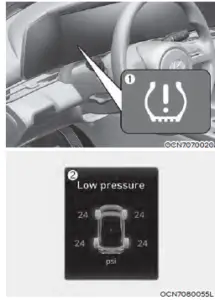
- Low Tire Pressure Telltale/TPMS Malfunction Indicator
- Low Tire Pressure Position Telltale and Tire Pressure Telltale (Shown on the LCD display)
Check Tire Pressure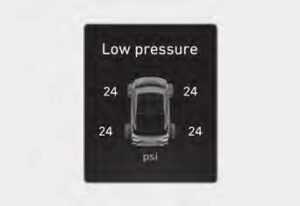
- You can check the tire pressure in the Assist mode on the cluster.
- Refer to the “LCD Display Modes” in chapter 4.
- Tire pressure is displayed after a few minutes of driving after the initial engine start-up.
- If tire pressure is not displayed when the vehicle is stopped, a “Drive to display” message will appear. After driving, check the tire pressure.
- The displayed tire pressure values may differ from those measured with a tire pressure gauge.
- You can change the tire pressure unit in the User Settings Mode on the cluster.
- psi, spa, bar (Refer to the “User Settings Mode” section in Chapter 4).
Tire Pressure Monitoring System
WARNING
Over-inflation or under-inflation can reduce tire life, adversely affect vehicle handling, and lead to sudden tire failure that may cause loss of vehicle control resulting in an accident. Each tire, including the spare (if provided), should be checked monthly when cold and inflated to the inflation pressure recommended by the vehicle manufacturer on the vehicle placard or tire inflation pressure label. (If your vehicle has tires of a different size than the size indicated on the vehicle placard or tire inflation pressure label, you should determine the proper tire inflation pressure for those tires.) As an added safety feature, your vehicle has been equipped with a tire pressure monitoring system (TPMS) that illuminates a low tire pressure telltale when one or more of your tires is significantly under-inflated. Accordingly, when the low tire pressure telltale illuminates, you should stop and check your tires as soon as possible, and inflate them to the proper pressure. Driving on a significantly underinflated tire causes the tire to overheat and can lead to tire failure. Under-inflation also reduces fuel efficiency and tire tread life, and may affect the vehicle’s handling and stopping ability. Please note that the TPMS is not a substitute for proper tire maintenance, and it is the driver’s responsibility to maintain correct tire pressure, even if under-inflation has not reached the level to trigger illumination of the TPMS low tire pressure telltale. Your vehicle has also been equipped with a TPMS malfunction indicator to indicate when the system is not operating properly. The TPMS malfunction indicator is combined with the low tire pressure telltale. When the system detects a malfunction, the telltale will flash for approximately one minute and then remain continuously illuminated. This sequence will continue upon subsequent vehicle start-ups as long as the malfunction exists. When the malfunction indicator is illuminated, the system may not be able to detect or signal low tire pressure as intended. TPMS malfunctions may occur for a variety of reasons, including the installation of replacement or alternate tires or wheels on the vehicle that prevent the TPMS from functioning properly. Always check the TPMS malfunction telltale after replacing one or more tires or wheels on your vehicle to ensure that the replacement or alternate tires and wheels allow the TPMS to continue to function properly.
NOTICE
If any of the below happens, have the system checked by an authorized HYUNDAI dealer.
- The Low Tire Pressure Telltale/ TPMS Malfunction Indicator does not illuminate for 3 seconds when the ignition switch is placed to the ON position or the engine is running.
- The TPMS Malfunction Indicator remains illuminated after blinking for approximately 1 minute.
- The Low Tire Pressure Position Telltale remains illuminated.
Low Tire Pressure Telltale
Low Tire Pressure Position and Tire Pressure Telltale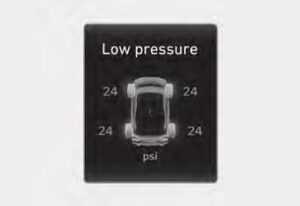
When the tire pressure monitoring system warning indicators are illuminated and a warning message is displayed on the cluster LCD display, one or more of your tires is significantly under-inflated. The Low Tire Pressure Position Telltale will indicate which tire is significantly underinflated by illuminating the corresponding position light.
If either telltale illuminates, immediately reduce your speed, avoid hard cornering, and anticipate increased stopping distances. You should stop and check your tires as soon as possible. Inflate the tires to the proper pressure as indicated on the vehicle’s placard or tire inflation pressure label located on the driver’s side center pillar outer panel.
If you cannot reach a service station or if the tire cannot hold the newly added air, replace the low-pressure tire with the spare tire.
The Low Tire Pressure Telltale will remain on and the TPMS Malfunction Indicator may blink for one minute and then remain illuminated (when the vehicle
is driven for approximately 10 minutes at a speed above 15.5 mph (25km/h)) until you have the low-pressure tire repaired and replaced on the vehicle.
Information
The spare tire is not equipped with a tire pressure sensor.
CAUTION
In winter or cold weather, the Low Tire Pressure Telltale may be illuminated if the tire pressure is adjusted to the recommended tire inflation pressure in warm weather. It does not mean your TPMS is malfunctioning because the decreased temperature leads to a proportional lowering of tire pressure. When you drive your vehicle from a warm area to a cold area or from a cold area to a warm area, or the outside temperature is greatly higher or lower, you should check the tire inflation pressure and adjust the tires to the recommended tire inflation pressure.
WARNING
Low-pressure damage
Significantly low tire pressure makes the vehicle unstable and can contribute to loss of vehicle control and increased braking distances. Continued driving on low-pressure tires can cause the tires to overheat and fail.
TPMS (Tire Pressure Monitoring System) Malfunction Indicator
The TPMS Malfunction Indicator will illuminate after it blinks for approximately one minute when there is a problem with the Tire Pressure Monitoring System. We recommend that the system be checked by an authorized HYUNDAI dealer.
NOTICE
If there is a malfunction with the TPMS, the Low Tire Pressure Position Telltale will not be displayed even though the vehicle has an under-inflated tire.
NOTICE
The TPMS Malfunction Indicator may illuminate after blinking for one minute if the vehicle is near electric power supply cables or radio transmitters such as police stations, government and public offices, broadcasting stations, military installations, airports, transmitting towers, etc. Additionally, the TPMS Malfunction Indicator may illuminate if snow chains are used or electronic devices such as computers, chargers, remote starters, navigation, etc. This may interfere with the normal operation of the TPMS.
Changing a Tire with TPMS
If you have a flat tire, the Low Tire Pressure and Position telltales will come on. We recommend that the flat tire be repaired by an authorized HYUNDAI dealer as soon as possible or replace the flat tire with a spare tire.
NOTICE
It is recommended that you do not use a puncture-repairing agent not approved by a HYUNDAI dealer to repair and/or inflate a low-pressure tire. Tire sealant not approved by a HYUNDAI dealer may damage the tire pressure sensor.
The spare tire (if equipped) does not come with a tire pressure monitoring sensor. When the low-pressure tire or the flat tire is replaced with the spare tire, the Low Tire Pressure Telltale will remain on. Also, the TPMS Malfunction Indicator will illuminate after blinking for one minute if the vehicle is driven
at speed above 15.5 mph (25km/h) for approximately 10 minutes.
Once the original tire equipped with
a tire pressure monitoring sensor is reinflated to the recommended pressure and reinstalled on the vehicle, the
Low Tire Pressure Telltale and TPMS Malfunction Indicator will go off within a few minutes of driving.
If the indicators do not extinguish after a few minutes, please visit an authorized HYUNDAI dealer.
Each wheel is equipped with a tire pressure sensor mounted inside the tire behind the valve stem (except for the spare tire). You must use TPMS-specific wheels. It is recommended that you always have your tires serviced by an authorized HYUNDAI dealer.
You may not be able to identify a tire with low pressure by simply looking at it. Always use a good quality tire pressure gauge to measure the tire’s inflation pressure. Please note that a tire that is hot (from being driven) will have a higher pressure measurement than a tire that is cold.
A cold tire means the vehicle has been sitting for 3 hours and driven for less than 1 mile (1.6 km) in that 3-hour period.
Allow the tire to cool before measuring the inflation pressure. Always be sure the tire is cold before inflating to the recommended pressure.
WARNING
The TPMS cannot alert you to severe and sudden tire damage caused by external factors such as nails or road debris. If you feel any vehicle instability, immediately take your foot off the accelerator, apply the brakes gradually with light force, and slowly move to a safe position off the road.
WARNING
Tampering with, modifying, or disabling the Tire Pressure Monitoring System (TPMS) components may interfere with the system’s ability to warn the driver of low tire pressure conditions and/or TPMS malfunctions. Tampering with, modifying, or disabling the Tire Pressure Monitoring System (TPMS) components may void the warranty for that portion of the vehicle.
Information
This device complies with Part 15 of the FCC rules. Operation is subject to the following three conditions:
- This device may not cause harmful interference.
- This device must accept any interference received, including interference that may cause undesired operation.
- Changes or modifications not expressly approved by the party responsible for compliance could void the user’s authority to operate the equipment.
If you Have a Flat Tire (With a spare tire)
WARNING
Changing a tire can be dangerous. Follow the instructions in this section when changing a tire to reduce the risk of serious injury or death.
CAUTION
Be careful as you use the jack handle to stay clear of the flat end. The flat end has sharp edges that could cause cuts.
Jack and Tools
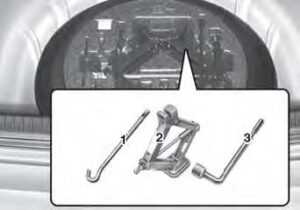 Jack handle
Jack handle- Jack
- Wheel lug nut wrench
The jack, jack handle, and wheel lug nut wrench are stored in the luggage compartment under the luggage box cover. The jack is provided for emergency tire changing only.

Turn the winged hold-down bolt counterclockwise to remove the spare tire. Store the spare tire in the same compartment by turning the winged hold-down bolt clockwise. To prevent the spare tire and tools from “rattling”, store them in their proper location.
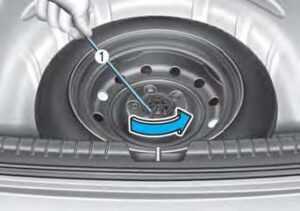
If it is hard to loosen the tire hold-down wing bolt by hand, you can loosen it easily using the jack handle.
- Put the jack handle (1) inside of the tire hold-down wing bolt.
- Turn the tire hold-down wing bolt counterclockwise with the jack handle.
Changing Tires
WARNING
A vehicle can slip or roll off of a jack causing serious injury or death to you or those nearby. Take the following safety precautions:
- Never place any portion of your body under a vehicle that is supported by a jack.
- NEVER attempt to change a tire in the lane of traffic. ALWAYS move the vehicle completely off the road on level, firm ground away from traffic before trying to change a tire. If you cannot find a level, firm place off the road, call a towing service for assistance.
- Be sure to use the jack provided with the vehicle.
- ALWAYS place the jack on the designated jacking positions on the vehicle and NEVER on the bumpers or any other part of the vehicle for jacking support.
- Do not start or run the engine while the vehicle is on the jack.
- Do not allow anyone to remain in the vehicle while it is on the jack.
- Keep children away from the road and the vehicle.
Follow these steps to change your vehicle’s tire:
- Park on a level, firm surface.
- Shift the shift lever into P (Park).
- Press the hazard warning flasher button.
- Remove the wheel lug nut wrench, jack, jack handle, and spare tire from the vehicle.

- Block both the front and rear of the tire diagonally opposite of the tire you are changing.
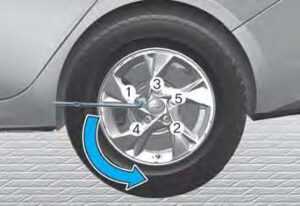
- Loosen the wheel lug nuts counterclockwise one turn each in the order shown above, but do not remove any lug nuts until the tire has been raised off of the ground.
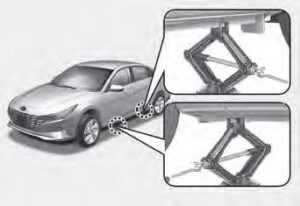
- Place the jack at the designated jacking position under the frame closest to the tire you are changing. The jacking positions are plates welded to the frame with two notches. Never jack at any other position or part of the vehicle. Doing so may damage the side sill molding or other parts of the vehicle.

- Insert the jack handle into the jack and turn it clockwise, raising the vehicle until the tire clears the ground. Make sure the vehicle is stable on the jack.
- Loosen the lug nuts with the wheel lug nut wrench and remove them with your fingers. Remove the wheel from the studs and lay it flat on the ground out of the way. Remove any dirt or debris from the studs, mounting surfaces, and wheel.
- Install the spare tire onto the studs of the hub.
- Tighten the lug nuts with your fingers onto the studs with the smaller end of the lug nuts closest to the wheel.
- Lower the vehicle to the ground by turning the jack handle counterclockwise.

- Use the wheel lug nut wrench to tighten the lug nuts in the order shown. Double-check each lug nut until they are tight. After changing tires, have an authorized HYUNDAI dealer tighten the lug nuts to their proper torque as soon as possible. The wheel lug nut should be tightened to 79~94 lbf·ft (11~13 kgf·m).
If you have a tire gauge, check the tire pressure (see “Tires and Wheels” in Chapter 2 for tire pressure instructions.). If the pressure is lower or higher than recommended, drive slowly to the nearest service station and adjust it to the recommended pressure. Always reinstall the valve cap after checking or adjusting tire pressure. If the cap is not replaced, air may leak from the tire. If you lose a valve cap, buy another and install it as soon as possible. After changing the tires, secure the flat tire and return the jack and tools to their proper storage locations. If it is hard to secure the flat tire, put the flat tire in the luggage compartment.
NOTICE
Check the tire pressure as soon as possible after installing a spare tire. Adjust it to the recommended pressure. Check and tighten the wheel lug nuts after driving over 30 miles (50 km), after the spare tire is installed. Recheck the tire wheel lug nuts after driving over 620 miles (1,000 km) after the replaced tire is reinstalled.
CAUTION
Your vehicle has metric threads on the studs and lug nuts. Make certain during tire changing that the same nuts that were removed are reinstalled. If you have to replace your lug nuts make sure they have metric threads to avoid damaging the studs and ensure the wheel is properly secured to the hub. Consult an authorized HYUNDAI dealer for assistance. If any of the equipment such as the jack, lug nuts, studs, or other equipment is damaged or in poor condition, do not attempt to change the tire and call for assistance. Use of compact spare tires (if equipped) Compact spare tires are designed for emergency use only. Drive carefully on the compact spare tire and always follow the safety precautions.
WARNING
To prevent compact spare tire failure and loss of control possibly resulting in an accident:
- Use the compact spare tire only in an emergency.
- NEVER operate your vehicle over 50 mph (80 km/h).
- Do not exceed the vehicle’s maximum load rating or the load-carrying capacity shown on the sidewall of the compact spare tire.
- Do not use the compact spare tire continuously. Repair or replace the original tire as soon as possible to avoid failure of the compact spare tire.
When driving with the compact spare tire mounted to your vehicle:
- Check the tire pressure after installing the compact spare tire. The compact spare tire should be inflated to 60 psi (420 kPa).
- Do not take this vehicle through an automatic car wash while the compact spare tire is installed.
- Do not use the compact spare tire on any other vehicle because this tire has been designed especially for your vehicle.
- The compact spare tire’s tread life is shorter than a regular tire. Inspect your compact spare tire regularly and replace worn compact spare tires with the same size and design, mounted on the same wheel.
- Do not use more than one compact spare tire at a time.
NOTICE
When the original tire and wheel are repaired and reinstalled on the vehicle, the lug nut torque must be set correctly. The correct lug nut tightening torque is 79~94 lbf·ft (11~13 kgf·m).
CAUTION
To prevent damaging the compact spare tire and your vehicle:
- Drive slowly enough for the road conditions to avoid all hazards, such as potholes or debris.
- Avoid driving over obstacles. The compact spare tire diameter is smaller than the diameter of a conventional tire and reduces the ground clearance by approximately 1 inch (25 mm).
- Do not use tire chains on the compact spare tire. Because of the smaller size, a tire chain will not fit properly.
- Do not use the compact spare tire on any other wheels, nor should standard tires, snow tires, wheel covers, or trim rings be used with the compact spare wheel.
- Do not suddenly accelerate or decelerate 0 25 mph (0 40 km/h) in any driving mode. It may cause leakage of transfer oil.
Jack label

The actual Jack label in the vehicle may differ from the illustration.
For more detailed specifications, refer to the label attached to the jack.
- Model Name
- Maximum allowable load
- When using the jack, set your parking brake.
- When using the jack, stop the engine.
- Do not get under a vehicle that is supported by a jack.
- The designated locations under the frame
- When supporting the vehicle, the base plate of the jack must be vertical under the lifting point.
- Shift into Reverse gear on vehicles with manual transmission or move the shift lever to the P (Park) position on vehicles with automatic transmission.
- The jack should be used on firm-level ground.
- Jack manufacture
- Production date
- Representative company and address
TOWING
Towing Service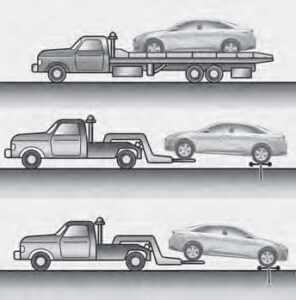
If emergency towing is necessary, we recommend having it done by an authorized HYUNDAI dealer or a commercial tow-truck service. Proper lifting and towing procedures are necessary to prevent damage to the vehicle. The use of wheel dollies or flatbeds is recommended. It is acceptable to tow the vehicle with the rear wheels on the ground (without dollies) and the front wheels off the ground. If any of the loaded wheels or suspension components are damaged or the vehicle is being towed with the front wheels on the ground, use a towing dolly under the front wheels. When being towed by a commercial tow truck and wheel dollies are not used, the front of the vehicle should always be lifted, not the rear.
CAUTION
- Do not tow the vehicle with the front wheels on the ground as this may cause damage to the vehicle.

- Do not tow with sling-type equipment. Use a wheel lift or flatbed equipment.

- Do not tow the vehicle with four wheels in contact with the ground if it is the vehicle equipped with IVT.
Otherwise, the transmission will be seriously damaged. Also, make sure not to tow the vehicle connecting it with other vehicles including camper vans.
WARNING
If your vehicle is equipped with a rollover sensor, place the ignition switch in the LOCK/OFF or ACC position when the vehicle is being towed. The side impact and curtain airbag may deploy if the sensor detects the situation as a rollover.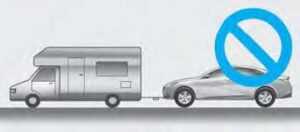
When towing your vehicle in an emergency without wheel dollies:
- Place the ignition switch in the ACC position.
- Place the shift lever in N (Neutral).
- Release the parking brake.
CAUTION
Failure to place the shift lever in N (Neutral) when being towed with the front wheels on the ground can cause internal damage to the transmission.
Emergency Towing
If towing is necessary, we recommend you have it done by an authorized HYUNDAI dealer or a commercial tow truck service.
Removable Towing Hook
- Open the trunk, and remove the towing hook from the tool case.
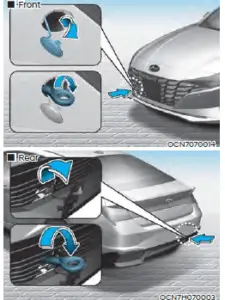
- Remove the hole cover by pressing the lower part of the cover on the bumper.
- Install the towing hook by turning it clockwise into the hole until it is fully secured.
- Remove the towing hook and install the cover after use.
Emergency Towing
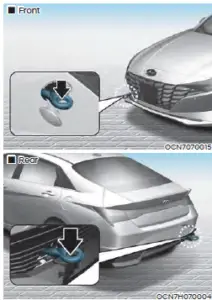
If towing is necessary, we recommend you have it done by an authorized HYUNDAI dealer or a commercial tow truck service. If towing service is not available in an emergency, your vehicle may be temporarily towed using a cable or chain secured to the emergency towing hook at the front (or rear) of the vehicle. Use extreme caution when towing the vehicle with a cable or chain. A driver must be in the vehicle to steer it and operate the brakes. Towing in this manner may be done only on hard-surfaced roads for a short distance and at low speeds. Also, the wheels, axles, power train, steering, and brakes must all be in good condition.
CAUTION
The driver must be in the vehicle for steering and braking operations when the vehicle is being towed. Passengers other than the driver must not be in the vehicle.
Always follow these emergency towing precautions:
- Place the ignition switch in the ACC position so the steering wheel is not locked.
- Place the shift lever in N (Neutral).
- Release the parking brake.
- Depress the brake pedal with more force than normal since you will have reduced braking performance.
- More steering effort will be required because the power steering system will be disabled.
- Use a vehicle heavier than your own to tow your vehicle.
- The drivers of both vehicles should communicate with each other frequently.
- Before emergency towing, check that the hook is not broken or damaged.
- Fasten the towing cable or chain securely to the hook.
- Do not jerk the hook. Apply steady and even force.
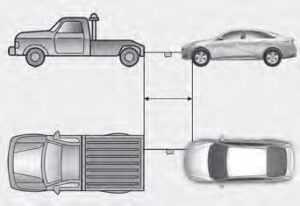
- Use a towing cable or chain less than 5 m (16 feet) long. Attach a white or red cloth (about 30 cm (12 inches) wide) in the middle of the cable or chain for easy visibility. Drive carefully so the towing cable or chain remains tight during towing. Before towing, check the Dual clutch transmission for fluid leaks under your vehicle. If the Dual clutch transmission fluid is leaking, flatbed equipment or a towing dolly must be used.
NOTICE
Accelerate or decelerate the vehicle in a slow and gradual manner while maintaining tension on the tow rope or chain to start or drive the vehicle, otherwise, tow hooks and the vehicle may be damaged.
NOTICE
To avoid damage to your vehicle and vehicle components when towing:
- Always pull straight ahead when using the towing hooks. Do not pull from the side or at a vertical angle.
- Do not use the towing hooks to pull a vehicle out of mud, sand or other conditions from which the vehicle cannot be driven out under its own power.
- Limit the vehicle speed to 10mph (15km/h) and drive less than 1 mile (1.5 km) when towing to avoid serious damage to the Dual clutch transmission.
- The Dual clutch transmission vehicle can be towed to a normal vehicle only without oil leakage. Check for oil leaks. Towing the vehicle with oil leakage may damage the transmission.
FAQ
The Declaration of Conformity is a document certifying that the 2023 Hyundai Elantra Hybrid meets specific safety and environmental standards.
It’s important as it ensures that the vehicle complies with regulatory standards, ensuring safety and environmental responsibility.
The Declaration typically lists safety standards and certifications the vehicle adheres to, such as crash safety ratings.
You can typically find it in your owner’s manual, on the Hyundai website, or request it from your dealership.
It should detail the vehicle’s environmental compliance, including emissions standards.
It may mention recommended maintenance intervals and procedures.
It may specify warranty details, including coverage periods and what’s included.
Emergency procedures should be outlined in a section dedicated to safety in the owner’s manual.
Look for contact numbers for roadside assistance, customer service, and emergency services in the owner’s manual.
Yes, it should include safety information related to the hybrid system.
Tire safety information, including maintenance and inflation guidelines, may be provided.
The owner’s manual should provide instructions for handling mechanical breakdowns, including contact information for roadside assistance.
Accident and collision procedures should be outlined in the owner’s manual for safety and legal reasons.
Yes, it may include recommendations for routine maintenance intervals.
The Declaration may include information on how Hyundai handles vehicle recalls and what to do if your vehicle is affected.
Useful Link
View Full User Guide: Hyundai Elantra Hybrid 2023 User Guide
Download Manuals: https://owners.hyundaiusa.com/us/en/resources/manuals-warranties.html
2023 Hyundai Elantra Specs, Price, Features, Milage (Brochure)


